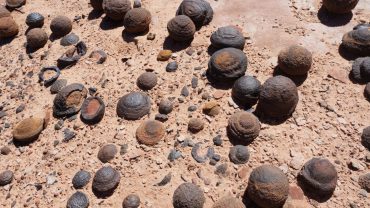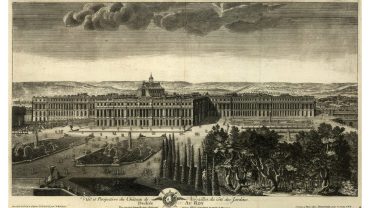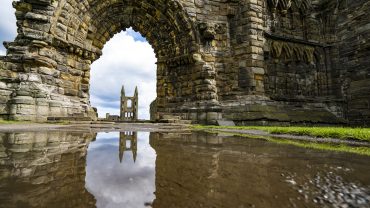One of the world’s legendary scoundrels, Captain Henry Morgan spent much of his life attacking Spanish ships with such brutal abandon and unspeakable violence he alone was a thorn in the side of the Spanish Empire for over two decades.
His individual exploits are too lengthy to list but the most famous are the 1668 sack of Portobelo, the raid on Maracaibo a year later and then his magnum opus, the attack on Panama in 1671.
Here, we’ll let you know about the astonishing exploits of the buccaneer Henry Morgan.
Who Was Captain Henry Morgan?

old worn map - the world in hemispheres (Photo: THEPALMER via Getty Images)
Captain Henry Morgan was a Welsh buccaneer who operated in the Caribbean during the 17th century. He gained a reputation as a ruthless pirate, leading a series of raids on Spanish colonial towns and cities. In 1671, he famously sacked old Panama City, one of the most lucrative Spanish settlements in the New World. He died in 1688, at the age of 53. Morgan’s raids made him one of the richest men in the Caribbean.
A Brief Biography of Captain Henry Morgan

Captain Morgan, 17th Century Buccaneer, C1880 (Photo: Print Collector / Contributor via Getty Images)
Born in or around 1635 in Monmouthshire – between Cardiff and Newport – very little of Morgan’s early life is known, aside from the fact that his formal education was brief. Indeed there is even uncertainty about how he ended up in the West Indies and how he became a privateer.
The Captain Morgan pirate history – or should we say privateer history – is fascinating.
One possible story was that he travelled to the West Indies as part of a force sent by Oliver Cromwell in 1655. Another suggests he served a three-year apprenticeship as a cutlery maker in return for passage. Yet another states that he was kidnapped in Bristol, and sold as a servant in Barbados.
During the Anglo-Spanish War, he joined a band of raiders in around 1660 led by naval officer and privateer Vice-Admiral Sir Christopher Myngs (also spelled Mings). He very quickly learned the trade of a freebooter.
With a burgeoning reputation as a buccaneer, Henry Morgan gained the friendship of the then Governor of Jamaica, Sir Thomas Modyford. In 1667 as the political situation between the English and Spanish got worse, Modyford issued Morgan with a Letter of Marque. This was what Morgan was waiting for.
A Letter of Marque is effectively a licence issued by a government that authorises an individual to engage in acts of state-sponsored piracy, plundering and capturing enemy vessels to prop up the eye-watering cost of war. In return for a share of the spoils, the actions of privateers were largely overlooked.
The privateer career of Captain Henry Morgan was about to begin.
What’s The Difference between a Pirate and a Privateer?

Old treasure map with nautical navigation equipment (Photo: wragg via Getty Images)
The difference between a pirate and a privateer is that pirates operate with no legal authority and for personal gain, while privateers are authorised and sanctioned by a government to attack enemy ships.
Captain Henry Morgan operated with the tacit approval of the British government. He was, therefore, a privateer. In return for his work, he was allowed to keep a percentage of the take.
Privateers were often utilised by governments during wartime to supplement their naval forces. While they were technically criminals, privateers were usually granted immunity in exchange for their loyal service. Morgan was eventually knighted by King Charles II and made Lieutenant-Governor of Jamaica.
Henry Morgan, pirate, buccaneer or privateer – whatever label he’s conferred with – was about to wreak havoc across Central and South America.
The Sack of Portobelo

Captain Morgan's defeat of the Spanish fleet (Photo: Print Collector via Getty Images)
Much of the famed Spanish gold passed through the city of Portobelo in modern-day Panama so it was ripe for attack. The Letter of Marque issued to Morgan from Modyford required him to ‘draw together the English privateers and take prisoners of the Spanish nation, whereby he might inform of the intention of that enemy to attack Jamaica, of which I have frequent and strong advice.’
Morgan attacked the city on the night of 11 July 1668, anchoring his fleet offshore and canoeing into the city’s ports. Most fell quickly but the last was a tough nut to crack. Morgan, quite astonishingly, rounded up the city’s nuns and used them as human shields knowing the staunchly religious Spaniards would never fire back. It worked. He captured the city and with it, its gold, money and jewels.
Desperate for his city back, the acting President of Panama paid a ransom of 100,000 pesos and Morgan and his men left, considerably richer than when they arrived. Morgan took five percent of the haul, Modyford got 10 percent, with the remainder of the spoils being split between the other raiders.
The Maracaibo Raid

Vintage engraving from 1878 showing Captain Henry Morgan's attack on Maracaibo, Venezuela ( Photo: duncan1890 via Getty Images)
A year after Portobelo, buccaneer Henry Morgan arrived in the Venezuelan port of Maracaibo with more ships, but far less firepower than the Spanish. A week’s worth of negotiations with Spanish captain Don Alonso del Campo y Espinosa – who had orders to end piracy in the Caribbean – yielded no positive results. Morgan ordered him to stand down. Don Alonso refused.
To counteract the Spanish firepower, one of Captain Henry Morgan’s ships was disguised with wooden guns and packed full of explosives. The ship – by now a fireball – was aimed directly at the Spanish fleet and set many of the ships ablaze causing the formation to split and in some cases, run – or sail – for the metaphorical hills.
The port was a sitting duck and Morgan earned 250,000 pieces of eight – the nickname for the Spanish dollar – as a ransom.
The Panama Attack

Henry Morgan's attack on Panama, 1671. Undated illustration (Photo: Bettmann / Contributor via Getty Images)
This was the big one. Morgan’s attack on Panama was his most audacious and complex raid. This was a city that had never fallen out of Spanish control.
With a considerable force of men and more than 30 ships, Henry Morgan, pirate, buccaneer, privateer or a mix of all three, advanced up the Chagres River in Satisfaction, his 22-gun frigate, taking the San Lorenzo fortress in the isthmus of Panama.
Heading for Panama City, by now on foot through dense jungle, they arrived on 27 January 1671 and were faced with 1,200 Spanish infantry, 400 cavalry and hundreds of rampaging bulls intended to put Morgan’s men off their stride.
It was a massacre. The Spanish lost around 500 men, the privateers, 15. They even killed some bulls so they could eat. Morgan ended up with around 400,000 pieces of eight but it could have been ten or twenty times that if the city hadn’t burned to the ground.
Henry Morgan - Real Pirates of the Caribbean

Panama city La Vieja old Spanish City destroyed by pirates (Photo: IAM-photography via Getty Images)
Except this is not a movie, it was real life. While Morgan and his merry men were allowed to plunder and pillage in wartime, a peace treaty was signed between England and Spain.
The Spanish demanded he be arrested, sent back to London and charged with piracy, given that it was believed the Panama attack was technically carried out during peacetime. He was sent to London in April 1672 but was never imprisoned.
Instead, almost two years later he was knighted by King Charles II and sent back to the Caribbean where he took up post as Lieutenant-Governor of Jamaica.
A hero to some, a villain to others, Captain Henry Morgan died on 25 August 1688 of – variously – tuberculosis, cirrhosis of the liver due to his vast alcohol consumption or dropsy, a buildup of fluid in the body’s tissue.
He was buried at Palisadoes Cemetery in Port Royal, Jamaica. Just four years later, an earthquake struck and the cemetery fell into the sea, taking Morgan’s body with it. A most fitting end to the fascinating life of Captain Henry Morgan, one of the world’s most famous – and brutal – privateers.












